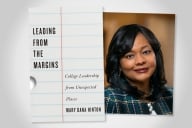You have /5 articles left.
Sign up for a free account or log in.
The sizable outcry against for-profit colleges and universities has only grown in the past few years, as federal and state investigations into these institutions have picked up steam and new regulations emerge.
In his book, Diploma Mills: How For-Profit Colleges Stiffed Students, Taxpayers, and the American Dream (Johns Hopkins University Press), Winthrop University history professor A. J. Angulo explores the history of for-profit institutions from the apprenticeship system of America's early decades to today's multibillion-dollar industry. Angulo explores how these institutions have grown over the centuries and evolved as the regulatory climate has increased.
Angulo posits that a long history of claims of quick degrees and in some cases false advertising about high job placement has plagued for-profit higher education. The history Angulo lays out begins with the apprenticeship system of the colonial era, where skilled tradesmen charged to teach their apprentices their crafts, and it extends to the evolution of 19th-century reading and writing schools to commercial or business colleges that promoted professional careers.
The following Q&A was condensed for clarity.
Q: A lot of ink has been spilled about for-profit colleges and universities. What will readers learn in this book about these institutions and what do you want readers to take away about the current state of the industry?
A: I got started on this project after reading through the jaw-dropping investigation into for-profits conducted by the U.S. Senate's Health, Education, Labor and Pensions Committee … For two years, this committee unearthed thousands of pages of data and evidence pointing toward serious abuses in the for-profit sector. As a historian and educational researcher, I immediately went looking for a history that would help put the investigation's results into context. I wanted a long view. It turned out that historians had been almost completely silent on the matter. So while much ink has been spilled since the ’90s by economists, sociologists, political scientists and legal researchers, there wasn't a single history of for-profits to be found. I wrote Diploma Mills because I wanted to read a book that had yet to be written.
There are many lessons to be learned from this history, but three key takeaways have to do with our assumptions about the efficient, responsive and innovative nature of for-profits. The record from start to finish just doesn't support these assumptions. If this history tells us anything, it's that we should critically question any time for-profit colleges and universities are celebrated for their efficiency, responsiveness and innovation.
Q: You make a very clear point that the essence of making a profit at for-profit institutions is the heart of the problem and can be traced back to the commercial colleges of the 1800s.
A: Profits are like drugs. Under certain regulated conditions, we're OK with them. Physicians administer them in professional contexts, and we trust experts with a great deal of training to use them appropriately. At the same time, U.S. public policy has waged war on unregulated drugs for decades. While some argue that the government has no place in controlling what we do with our bodies, the prevailing temper is that certain drugs have a corrosive effect on society and should be legislated out of existence.
When it comes to for-profit colleges and universities [FPCUs], a similar pattern has emerged over time: people have long wanted these institutions to be either highly regulated or legislated out of existence. They've witnessed firsthand the corrosive effects of profit-driven institutions that have operated without regulation or have circumvented the spirit and letter of the law. Whether it's the 19th-century fly-by-night institution or today's multinational chain, the pattern has been surprisingly consistent. FPCUs have had enormous difficulty maintaining the kind of professional and academic standards that have been the lifeblood of nonprofit colleges and universities for centuries. FPCUs have had a tendency to cut corners and reduce expenses to the point of shortchanging students and disregarding professional expertise. That's why organizations representing the legal and medical professions at the very start of the 20th century rejected for-profits. That's why civic groups in the decades that followed pressured state legislatures to ban the worst practices performed by these institutions. That's why midcentury reformers rallied against “sheep skinners” and “shysters” of the proprietary sector. And that's why we continue to see students and taxpayers in litigation against for-profits like Corinthian, ITT Technical Institute and Trump University. The bottom line is that this history bears out an inherent conflict between the pursuit of profit and the advancement and diffusion of professional and academic standards.
As I explain in Diploma Mills, profit motives have complicated the higher education landscape since the colonial period.
Q: In the book, you argue that for-profits should be removed from the federal student aid program. Wouldn't this put at risk the thousands of students who attend these institutions and are seeking higher education for the first time?
A: The assumption here is that all for-profits will disappear if removed from the federal student aid program. I'm not sure I agree with that. Some might contest this assumption by saying that it underestimates the power of American ingenuity rooted in free-market principles.
Let's assume, however, that for-profits can't support themselves without federal aid. That still leaves us with the question, What's riskier? Having students continue to sign up for tens of thousands of dollars in loans for degrees that fail to live up to the marketing hype? Or creating a vacuum that jump-starts a national conversation about making a wide range of nonprofit colleges affordable and accessible? Just because for-profits make it easier for first-generation students to access their programs doesn't mean that they graduate with the skills and training they need to break out of cycles of poverty. In fact, history tells us just the opposite, and staying the course, to my mind, is far riskier in the long run.
Q: What needs to happen in order for some for-profit institutions to stop operating as diploma mills?
A: Regulation is the go-to solution for many scholars. That's probably what I would have suggested before doing the research for Diploma Mills. After studying this higher education history, however, I'm no longer convinced that it'll do the trick. For-profits have had great success undermining regulations through the use of sophisticated lobbying efforts. They're good at it. And there's no sign that they'll stop watering down key rules. For students, especially first-generation students, to make informed decisions, they need to have access to accurate information about an institution's recruitment practices, loan options, graduation rates, student loan defaults and placement rates. These are precisely the areas for-profit colleges and universities have succeeded in bending regulations to their benefit at the expense of students, taxpayers and the American dream. The solution I offer is embedded in the book's conclusion. It's not one that plays well as a sound bite, but it's the first one that's based on and most responsive to the historical record.








